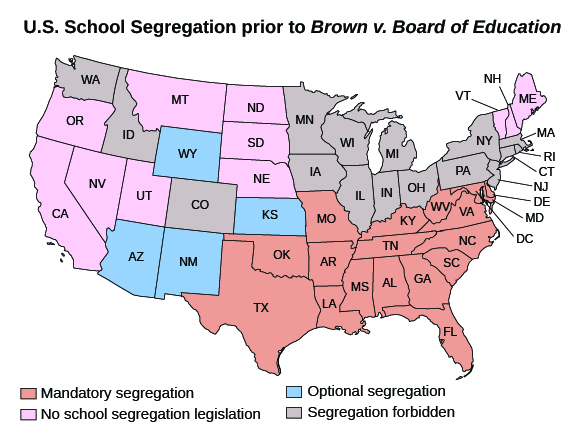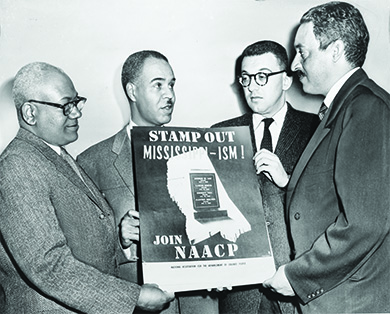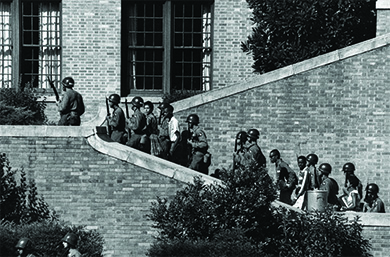Brown v. Board of Education of Topeka, Kansas
- Racial segregation in education persisted as a stark reality in American society, perpetuating inequality and denying equal opportunities to minority students.
- Thurgood Marshall’s steadfast commitment to fighting racism catalyzed legal efforts to dismantle segregation, reshaping the landscape of civil rights activism and legal precedent.
- Enforcing Brown v. the Board of Education marked a pivotal moment in American history, challenging institutionalized racism and affirming the constitutional principle of equality in education for all.
Desegregation and integration
Until 1954, racial segregation in education was not only legal but was required in seventeen states and permissible in several others (Figure). Utilizing evidence provided in sociological studies conducted by Kenneth Clark and Gunnar Myrdal, however, Thurgood Marshall, then chief counsel for the NAACP, successfully argued the landmark case Brown v. Board of Education of Topeka, Kansas before the U.S. Supreme Court led by Chief Justice Earl Warren. Marshall showed that the practice of segregation in public schools made African American students feel inferior. Even if the facilities provided were equal in nature, the Court noted in its decision, the very fact that some students were separated from others on the basis of their race made segregation unconstitutional.

This map shows those states in which racial segregation in public education was required by law before the 1954 Brown v. Board of Education decision. In 1960, four years later, fewer than 10 percent of southern African American students attended the same schools as white students.
Thurgood Marshall on Fighting Racism
As a law student in 1933, Thurgood Marshall (Figure) was recruited by his mentor Charles Hamilton Houston to assist in gathering information for the defense of a black man in Virginia accused of killing two white women. His continued close association with Houston led Marshall to aggressively defend blacks in the court system and to use the courts as the weapon by which equal rights might be extracted from the U.S. Constitution and a white racist system. Houston also suggested that it would be important to establish legal precedents regarding the Plessy v. Ferguson ruling of separate but equal.

In 1956, NAACP leaders (from left to right) Henry L. Moon, Roy Wilkins, Herbert Hill, and Thurgood Marshall present a new poster in the campaign against southern white racism. Marshall successfully argued the landmark case Brown v. Board of Education (1954) before the U.S. Supreme Court and later became the court’s first African American justice.
By 1938, Marshall had become “Mr. Civil Rights” and formally organized the NAACP’s Legal Defense and Education Fund in 1940 to garner the resources to take on cases to break the racist justice system of America. A direct result of Marshall’s energies and commitment was his 1940 victory in a Supreme Court case, Chambers v. Florida, which held that confessions obtained by violence and torture were inadmissible in a court of law. His most well-known case was Brown v. Board of Education in 1954, which held that state laws establishing separate public schools for black and white students were unconstitutional.
Later in life, Marshall reflected on his career fighting racism in a speech at Howard Law School in 1978:
Be aware of that myth, that everything is going to be all right. Don’t give in. I add that, because it seems to me, that what we need to do today is to refocus. Back in the 30s and 40s, we could go no place but to court. We knew then, the court was not the final solution. Many of us knew the final solution would have to be politics, if for no other reason, politics is cheaper than lawsuits. So now we have both. We have our legal arm, and we have our political arm. Let’s use them both. And don’t listen to this myth that it can be solved by either or that it has already been solved. Take it from me, it has not been solved.
When Marshall says that the problems of racism have not been solved, to what was he referring?
Plessy v. Fergusson had been overturned. The challenge now was to integrate schools. A year later, the U.S. Supreme Court ordered southern school systems to begin desegregation “with all deliberate speed.” Some school districts voluntarily integrated their schools. For many other districts, however, “deliberate speed” was very, very slow.
It soon became clear that enforcing Brown v. the Board of Education would require presidential intervention. Eisenhower did not agree with the U.S. Supreme Court’s decision and did not wish to force southern states to integrate their schools. However, as president, he was responsible for doing so. In 1957, Central High School in Little Rock, Arkansas, was forced to accept its first nine African American students, who became known as the Little Rock Nine. In response, Arkansas governor Orval Faubus called out the state National Guard to prevent the students from attending classes, removing the troops only after Eisenhower told him to do so. A subsequent attempt by the nine students to attend school resulted in mob violence. Eisenhower then placed the Arkansas National Guard under federal control and sent the U.S. Army’s 101st airborne unit to escort the students to and from school as well as from class to class (Figure). This was the first time since the end of Reconstruction that federal troops once more protected the rights of African Americans in the South.

In 1957, U.S. soldiers from the 101st Airborne were called in to escort the Little Rock Nine into and around formerly all-white Central High School in Little Rock, Arkansas.
Throughout the school year, the Little Rock Nine were insulted, harassed, and physically assaulted; nevertheless, they returned to school each day. At the end of the school year, the first African American student graduated from Central High. At the beginning of the 1958–1959 school year, Orval Faubus ordered all of Little Rock’s public schools closed. In the opinion of white segregationists, keeping all students out of school was preferable to having them attend integrated schools. In 1959, the U.S. Supreme Court ruled that the school had to be reopened and that the process of desegregation had to proceed.
- How did racial segregation in education contribute to systemic inequality and hinder the pursuit of equal opportunities for minority students in American society?
- What were the key strategies and legal arguments employed by Thurgood Marshall and civil rights activists to challenge racial segregation in education, and what impact did their efforts have on shaping the legal landscape of racial equality?
- In what ways did the Supreme Court’s decision in Brown v. the Board of Education challenge the prevailing notion of institutionalized racism, and how did it pave the way for subsequent efforts to address racial disparities in education and beyond?
The African American Struggle for Civil Rights. (n.d.). OER Commons. Retrieved August 15, 2022, from https://www.oercommons.org/courseware/lesson/15544
License: Creative Commons Attribution Non-Commercial

